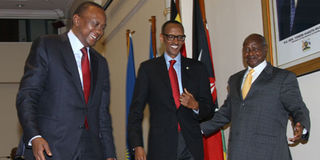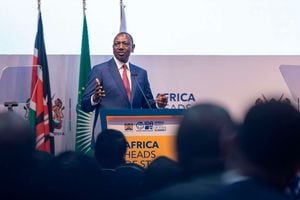East Africa's ‘Coalition of the Willing’ is just an alternative name for integration

Presidents Uhuru Kenyatta, Yoweri Museveni and Paul Kagame after Trilateral talks in Entebbe Uganda.PPS
What you need to know:
- In my view, the so-called coalition of the willing initiative is more an attempt to approach economic integration in Africa differently.
- The economies of East Africa still remain very closed and restrictive to movement of persons, labour and capital.
- In the future, economic integration will be about integrating an developing supply chains, rather than formal EU-style integration.
Some analysts have interpreted the trilateral discussions between Kenya, Uganda and Rwanda as an attempt to sideline Tanzania.
I choose to look at the bigger picture. In my view, the so-called coalition of the willing initiative is more an attempt to approach economic integration in Africa differently.
In East Africa, we adopted the European Union model that put the accent on trade liberalisation: a customs union, a common external tariff and a common market protocol. Right now, we are negotiating how to introduce a monetary union and a common currency.
The whole process has been steered from Arusha, Tanzania, where we have a supranational bureaucracy known as the East African Community. It is run by highly-paid bureaucrats carrying big titles. I have never encountered so many “director-generals” in one place.
But what’s in it for the ordinary citizen of East Africa? Not much. The process of economically integrating the region has been moving at a snail’s pace.
We have had a customs union protocol complete with a common external tariff since January 2005. Eight years down the line, we still don’t have even a common customs administration.
Instead, what we have witnessed is the proliferation of all forms of Non-Tariff Barriers – police road-blocks, weighbridges, multiple clearance forms at customs entry points, and border controls – a whole host of them.
Way back in July 2010, we signed a full-fledged common market protocol that came with hopes of free movement of labour, services, capital and right of establishment. Yet the economies of East Africa still remain very closed and restrictive to movement of persons, labour and capital.
What lessons have we learnt? First, that in Africa, economic integration projects which put emphasis on trade liberalisation will always progress slowly.
READ: Tanzanian government officially renounces ‘coalition of the willing’
Truth be told, countries do not want to surrender sovereignty especially when it comes to immigration, land, labour and right of establishment. Tanzania has made it clear that it will not surrender its prerogative on some of these issues.
Two weeks ago, President Jakaya Kikwete openly admitted that his country will not agree to be rushed into deals on immigration, movement of labour and land. Is it really accurate to claim that the country is being sidelined?
What presidents Yoweri Museveni, Uhuru Kenyatta and Paul Kagame have done is to move the economic integration agenda beyond tacky issues.
It is case where three countries which share supply chains have entered into a deal to deepen economic integration on the corridor that connects them.
Mark you, the three countries share a common supply chain known as the Northern corridor which starts from the Port of Mombasa stretching to Malaba on the border of Kenya and Uganda, all the way to Central Africa.
More and more, we are going to see willing neighbours signing memoranda of understanding, agreeing to come together to build oil pipelines, railway lines, and power transmission lines to connect their economies.
Kenya has signed a deal to connect its electricity grid with Ethiopia’s. Southern Sudan has signed a memorandum of understanding whereby Kenya will assist it to build a pipeline from Juba to the Port of Lamu. Tanzania and Kenya are thinking about building a gas pipeline connecting to Mombasa.
In the future, economic integration will be about integrating an developing supply chains. Rather than formal EU-style integration, what will bring East Africa together economically are the large infrastructure projects.
And, instead of approaching integration through negotiations driven by supra-national bodies such as the Arusha-based bureaucracy, deals negotiated at inter-governmental levels are the ones which will push the integration project faster.
Indeed, what will drive economic integration in Africa faster are MoUs and loosely-negotiated inter-governmental deals.
I have heard Tanzanian politicians urging their government to do a parallel deal with Burundi and the Democratic Republic of Congo. That will be good for Africa. When governments invest in infrastructure and supply chains that connect countries, it is the business community in the region which benefits.
Tanzania has no reason to worry about the activities of the coalition of the willing.





